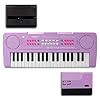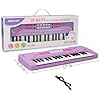Table of Contents
Learning Piano with a Focus on Rhythm
Mastering the piano involves a deep understanding of various musical elements, with rhythm being fundamental. Rhythm, the pattern
of musical movement through time, provides the scaffolding for melody and harmony. This introduction explores efficient strategies and tools
for enhancing rhythmic skills while learning the piano. Emphasizing temporal precision and expressive timing can
significantly improve your overall piano playing prowess and musicality.
Understanding the Basics of Rhythm and Timing
Learning piano with an emphasis on rhythm involves grasping the fundamental concepts that govern how music moves and feels. Understanding rhythm and timing is crucial, as it affects not just the melody but also the overall musical experience.
RockJam RJ761 61 Key Keyboard Piano with Keyboard Bench, Digital Piano Stool, Sustain Pedal, Headphones & Lessons
$159.85 (as of December 20, 2025 22:54 GMT -08:00 - More infoProduct prices and availability are accurate as of the date/time indicated and are subject to change. Any price and availability information displayed on [relevant Amazon Site(s), as applicable] at the time of purchase will apply to the purchase of this product.)Donner DDP-300 Digital Piano with 88 Graded Hammer Action Weighted Keys, Record, Bluetooth, 10 Voices, 4 Reverb, Speakers, Professional Full Fize Key Keyboard Electric Dark Rose
17% OffDonner DEP-20 Beginner Digital Piano 88 Key Full Size Weighted Keyboard, Portable Electric Piano with Furniture Stand, 3-Pedal Unit
15% OffYAMAHA P71 88-Key Weighted Action Digital Piano with Sustain Pedal and Power Supply (Amazon-Exclusive)
6% OffThe beat is the basic unit of time in music, the pulse you feel in the background, which is consistent throughout the piece. The tempo determines how fast or slow the piece is played and is measured in beats per minute (BPM). Increasing or decreasing the tempo can dramatically alter the feel of the music.
The meter refers to the pattern of the beats. It’s grouped into measures as indicated by the time signature. The time signature, written at the beginning of a piece of music, specifies how many beats are in each measure and which type of note receives one beat. For example, a 4/4 time signature means each measure contains four beats, and a quarter note represents one beat.
Note durations indicate how long a note should be held relative to the beat. Common note durations include whole notes, half notes, quarter notes, eighth notes, and sixteenth notes. Each has a specific time value and understanding these will help in executing rhythms accurately.
Rhythmic patterns are sequences of notes and rests that occur throughout a piece. These patterns can be simple or complex depending on the composition. Mastery of rhythmic patterns helps in interpreting music more faithfully and enhances expressiveness in playing.
QMG Rainbow Color Piano and Keyboard Sticker and Kids Piano Learning Book Easy to Follow Instructions for Kids, Beginner Piano Book for Children, Easy Piano Sheet Music for Kids
$14.95 (as of December 20, 2025 23:58 GMT -08:00 - More infoProduct prices and availability are accurate as of the date/time indicated and are subject to change. Any price and availability information displayed on [relevant Amazon Site(s), as applicable] at the time of purchase will apply to the purchase of this product.)Hal Leonard Rhythm and Counting: The Practical Handbook for Mastering Rhythm – Music Theory and Timing Exercises with Online Audio
Sight Reading Mastery for Guitar: Unlimited reading and rhythm exercises in all keys (Learn guitar theory and technique)
$8.99 (as of December 20, 2025 23:58 GMT -08:00 - More infoProduct prices and availability are accurate as of the date/time indicated and are subject to change. Any price and availability information displayed on [relevant Amazon Site(s), as applicable] at the time of purchase will apply to the purchase of this product.)How to Read Bass Clef on the Piano | Left Hand Piano Reading Workbook for Beginners and Music Students | Bass Staff Note Reading Guide and Piano Instruction Book for Sightreading Practice
Syncopation involves placing emphasis on beats or parts of beats that are typically not emphasized. This technique adds excitement and unpredictability to music, making it feel more dynamic. Understanding and applying syncopation effectively requires not only a good sense of rhythm but also creativity.
Using a metronome is essential for developing a strong sense of timing. It helps in maintaining a consistent tempo, which is vital for both solo performance and ensemble play. Practicing with a metronome ensures that you develop a steady internal rhythm, crucial for playing complex compositions.
Exercise 1: Metronome Practice
One of the foundational tools for improving rhythmic precision when learning piano is the metronome. Begin by setting the metronome to a comfortable beat per minute (BPM) and simply play quarter notes in time with each tick. As you become more comfortable, increase the tempo, or add complexity to your playing by incorporating eighth notes, sixteenth notes, and various rhythms. The key is to maintain consistency in timing, ensuring each note is played exactly in sync with the metronome’s tick.
Exercise 2: Rhythmic Solfege
In this exercise, attach syllables like “ta” for quarter notes, “ti-ti” for eighth notes, and “tika-tika” for sixteenth notes. Speak the rhythms out loud before playing them on the piano. This practice helps internalize the rhythmic patterns and improves overall rhythmic reading and execution.
Exercise 3: Clapping and Counting
Before playing any piece, clap and count out loud the rhythms of each measure. This method reinforces the understanding and precision of the written rhythm. Start slowly, focusing on accuracy, then gradually increase speed while retaining the rhythm’s clarity and correctness.
Exercise 4: Playing Along with Music
Use recordings of songs or backing tracks to practice playing in time. Choose pieces that vary in rhythm and tempo to challenge your abilities and adapt your playing. Focus on syncing precisely with the beats and the rhythmic patterns of the music, which will help develop your rhythmic accuracy and musicality.
Exercise 5: Dotted Rhythm Practice
Practice playing dotted rhythms, which involve combining a longer note followed by a shorter one. For instance, start with a dotted quarter note followed by an eighth note. This exercise helps in understanding and performing rhythms that are not evenly spaced, thereby enhancing rhythmic agility and precision.
Exercise 6: Subdivision Method
Break down each beat into smaller subdivisions, such as dividing a quarter note into two eighth notes or four sixteenth notes. Counting and playing these subdivisions out loud before playing full rhythms help to achieve greater control over complex rhythmic passages and syncopation.
Exercise 7: Rhythm Imitation
Listen to a short rhythmic pattern played by a teacher, recording, or metronome, and then immediately try to replicate it on the piano. Repeat this exercise with increasing complexity to improve your auditory recall and rhythmic reproduction skills.
Exercise 8: The Rhythmic Dictation
Write down rhythms by ear. Listen to a piece of music and attempt to transcribe the rhythms you hear onto paper. Start with simpler pieces and gradually work towards more complex rhythms. This practice not only improves rhythmic listening skills but also enhances notation and timing accuracy.
Learning to Play in Different Time Signatures
Mastering various time signatures is crucial for developing rhythmic versatility on the piano. Here’s a step-by-step guide focusing on common and uncommon time signatures.
The 4/4 time signature, also known as common time, is one of the most frequently encountered time signatures in Western music. Each measure has four beats, and each beat is represented by a quarter note. To practice in 4/4:
In 3/4 time, also known as waltz time, each measure contains three quarter-note beats. To adapt:
Time signatures like 6/8 are compound because they group beats into larger, dotted note pulses. In 6/8, a measure consists of six eighth notes grouped in two beats of three eighth notes each. To master 6/8:
Complex time signatures like 5/4 or 7/8, where beats are grouped asymmetrically, present unique challenges.:
How to Sync Rhythm with Melody and Harmony
Syncing rhythm with melody and harmony is crucial for playing the piano effectively, particularly when focusing on rhythm. Here are detailed steps to help you achieve a smooth integration:
Rhythm, melody, and harmony have distinct roles, but they must work together synergistically. Rhythm provides the temporal framework, melody is the sequence of notes that is perceived as the main tune, and harmony refers to the combination of simultaneously played notes that support the melody.
Begin by clapping or tapping the rhythm of the piece without playing any notes. This helps you internalize the timing and feel of the music. Ensure that you are comfortable with the tempo and rhythmic patterns before adding melody or harmony.
Once you are confident with the rhythm, start incorporating the melody. Play the melody slowly along with the rhythm, focusing on maintaining the correct tempo and rhythmical precision. Listen carefully to how the melody interacts with the underlying rhythm.
After mastering the melody with the right rhythm, begin to add harmony. Start with simple chords or a straightforward accompaniment pattern. Make sure that the addition of harmony does not disrupt the rhythm or melody. It should enhance the overall sound without overpowering the melody.
Use a metronome to keep your playing steady. It is a crucial tool for ensuring that the rhythm stays consistent as you add more layers of music. Adjust the metronome speed according to your comfort level, increasing it gradually as you get better.
Listen to recordings of professional pianists performing the pieces you are learning. Pay specific attention to how they balance rhythm, melody, and harmony. Try to emulate this balance in your playing, adjusting as needed based on what you hear.
Regular practice is key to mastering the synchronization of rhythm, melody, and harmony. Dedicate time each practice session to focus specifically on how these elements interact and support each other in the pieces you are learning.
By following these steps, you will enhance your ability to integrate rhythm with melody and harmony on the piano, leading to more cohesive and dynamic performances.
Using Drumming Techniques to Enhance Piano Rhythm
Drumming techniques are instrumental in building a strong rhythmic foundation, which can significantly enhance piano playing skills. By incorporating drumming exercises into piano practice routines, pianists can improve their timing, precision, and rhythmic awareness. Here are some drumming techniques that can be applied to piano practice:
1. Paradiddles
A paradiddle is a common drumming pattern used by drummers to practice stick control, but it can also improve finger independence and control on the piano. The basic paradiddle pattern (right-left-right-right, left-right-left-left) can be played on the piano by alternating hands or fingers, which enhances coordination and rhythmic precision.
2. Rhythmic Solfège
Rhythmic solfège involves speaking out rhythm syllables (e.g., ta, ti-ti) while playing. This method helps pianists internalize rhythms before playing them, fostering a deeper understanding and consistency in performance. By vocalizing rhythms, pianists can better manage complex syncopations and irregular time signatures common in more advanced compositions.
3. Metronome Drills
Using a metronome is a traditional approach in both drumming and piano practice. To enhance rhythmic accuracy, pianists should practice scales, arpeggios, and pieces with a metronome set at varying speeds. Gradually increasing the tempo allows for building speed without sacrificing precision, mirroring a drummer’s approach to mastering tempo control.
4. Ghost Note Incorporation
In drumming, ghost notes are soft, subtle beats that add texture and rhythm without dominating the sound landscape. Pianists can apply a similar concept by incorporating lighter, subtler notes into their playing to emphasize the main rhythmic motifs, enhancing the overall musical expression and dynamic range of their performances.
5. Poly-rhythmic Exercises
Drummers often practice poly-rhythms —simultaneous contrasting rhythms— to improve their rhythmic dexterity. Pianists can develop poly-rhythmic skills by playing different rhythms with each hand. Starting with simple contrasting patterns and gradually moving to more complex combinations can significantly enhance hand independence and rhythmic complexity in piano playing.
Conclusion
In conclusion, mastering the piano with an emphasis on rhythm involves consistent practice, a deep understanding of musical theory, and the use of technology and tools. It’s important to start with basic rhythms and progressively move to more complex patterns. Employing metronomes and rhythm training software enhances timing and rhythmic accuracy. Additionally, learning through different musical styles can provide varied rhythmic contexts, making the learning process engaging and comprehensive. Regular feedback from instructors and self-assessment are crucial for continuous improvement and mastery of rhythmic skills in piano playing.



































































